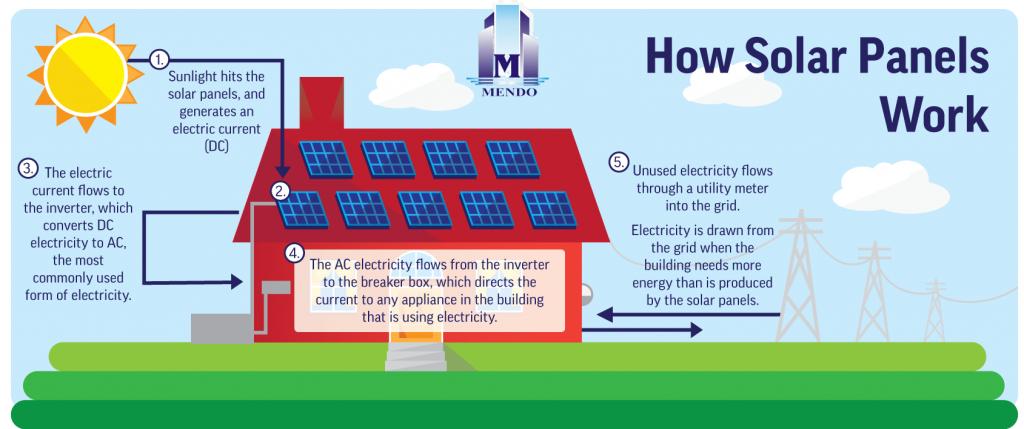HOW SOLAR PANELS WORK?
by mendo

How solar Panels work
Solar photovoltaic (PV) panels convert sunlight into usable power, but few people understand the science behind the process. It may appear difficult, but it all boils down to the photovoltaic effect, which is the capacity of materials to release electrons when exposed to light.
Here is a high-level look at how electricity is generated:

The Fundamentals of Solar Energy Generation and Transmission
– Sunlight strikes the solar panels, generating an electric field.
– The produced power goes to the panel’s edge and into a conductive wire.
– The conductive cable transports the electricity to the inverter, where it is converted from direct current (DC) to alternating current (AC), which is used to power buildings.
– Another wire transfers the alternating current power from the inverter to the property’s electric panel (also known as a breaker box), which distributes the electricity as needed throughout the building.
– Any power that is not required at the time of generation is routed through the utility meter and into the utility electrical grid. The flow of power through the meter leads the meter to run backwards, crediting your property for excess generation.
The Science of Solar PV Cells

Solar PV panels are made up of several tiny photovoltaic cells that can convert sunlight into energy. These cells are constructed of semi-conductive materials, most often silicon, which can conduct electricity while retaining the electrical imbalance required to generate an electric field.
When sunlight strikes the semiconductor in a solar PV cell (step 1 in our high-level review), the light’s energy, in the form of photons, is absorbed, causing a number of electrons to be released and float freely inside the cell. The solar cell is made up of positively and negatively charged semiconductors stacked together to provide an electric field.
This electric field pushes the electrons to move in one direction—toward the conductive metal plates that border the cell. This flow is referred to as an energy current, and its strength affects how much electricity each cell can produce. When free electrons collide with metal plates, current is routed into wires, letting electrons flow as they would in any other source of electric generating.
When a solar panel creates an electric current, the energy is transferred to an inverter through a network of cables. While solar panels provide direct current (DC) electricity, the majority of electricity users require alternating current (AC) electricity to operate their structures.
The inverter’s job is to convert the power from direct current (DC) to alternating current (AC), making it usable in everyday situations.
After the energy is converted into usable form (AC power), it is routed from the inverter to the electrical panel (also known as a breaker box) [step 4] and distributed as needed throughout the building. Solar energy is now widely accessible for powering lights, appliances, and other electrical equipment.
Any power not utilized through the breaker box is delivered to the utility grid via the utility meter (our last step, as outlined above). The utility meter tracks the flow of power from the grid to your home and back. When your solar energy system generates more electricity than you need on-site, this meter reverses and you are rewarded for the extra electricity generated through the net metering procedure. When you use more power than your solar array generates, you draw supplemental electricity from the grid via this meter, causing it to function correctly.
Unless you have gone entirely off-grid with a storage system, you will need to use some grid electricity, especially at night when your solar array is not generating. However, most of this grid energy will be countered by extra solar energy generated throughout the day and during periods of reduced demand.
While the science underlying solar is complex, it doesn’t take a scientist to understand the benefits a solar installation may provide to a business or property owner. An expert solar developer can guide you through these advantages and assist you in determining whether a solar solution is suited for your company.
Do you need constant supply of electricity through solar energy?
We are a call away….
08068414733, 08077166314
Email: info@mendo.com.ng
How solar Panels work Solar photovoltaic (PV) panels convert sunlight into usable power, but few people understand the science behind the process. It may appear difficult, but it all boils down to the photovoltaic effect, which is the capacity of materials to release electrons when exposed to light. Here is a high-level look at how…